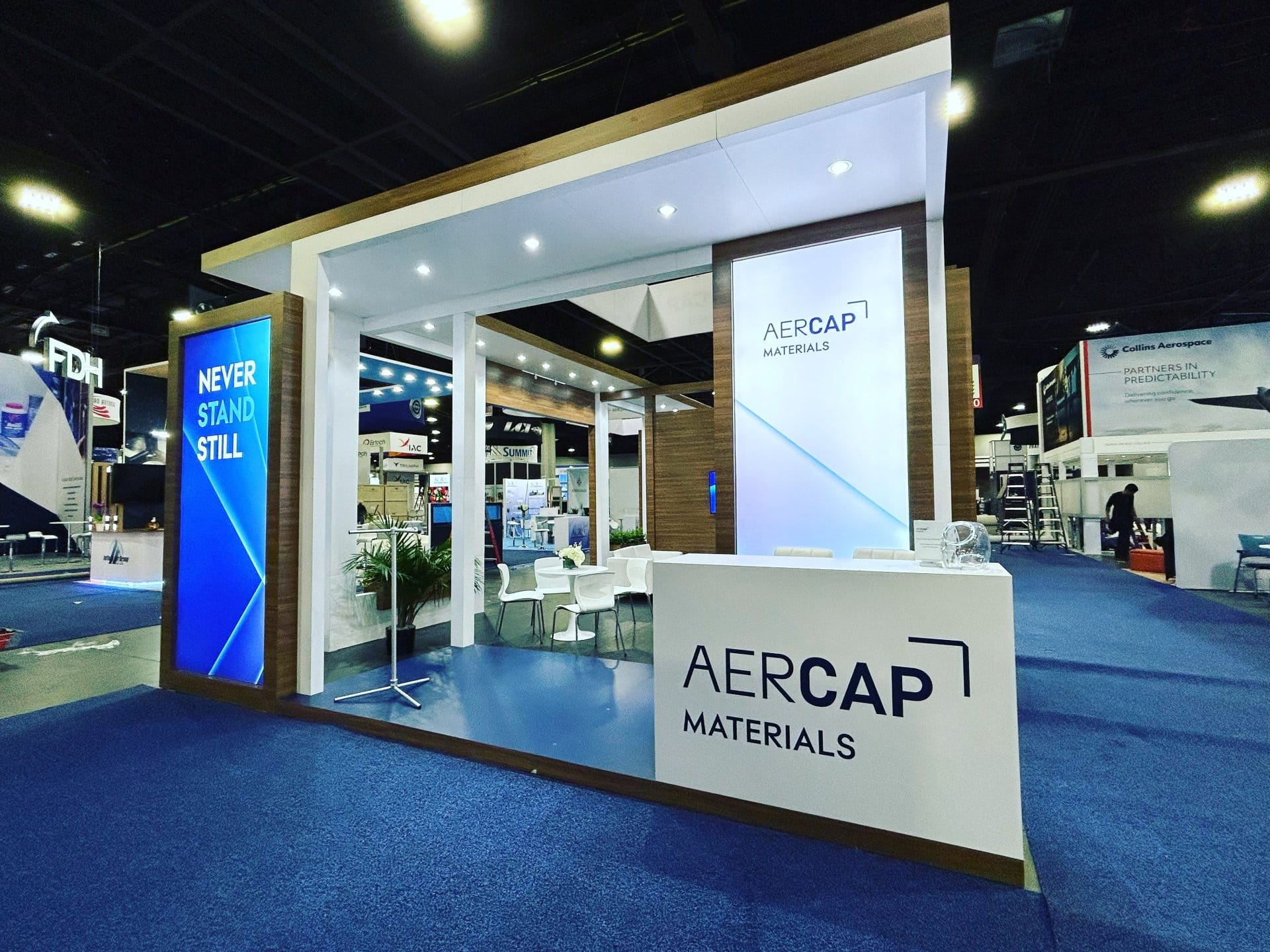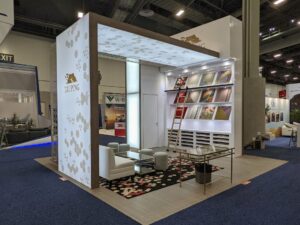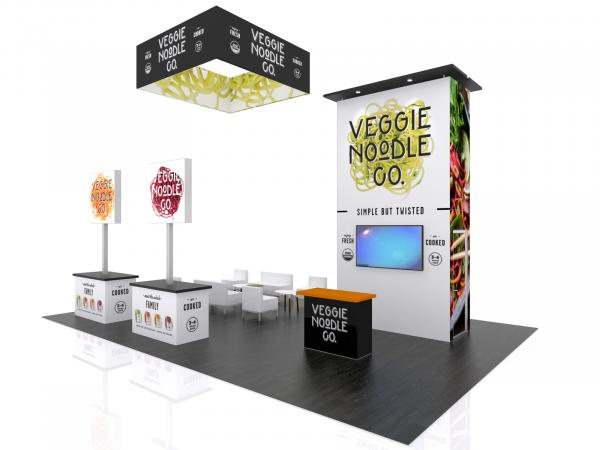Choosing the right booth size for trade shows is crucial for maximizing your impact and meeting your business objectives. The size of your booth not only determines how you display your products or services but also influences visitor engagement and interaction. A booth too small may seem overcrowded and uninviting, while one too large might appear intimidating or sparse, affecting the visitor’s perception and experience. This decision impacts not just the aesthetic appeal but also practical aspects like budget, design flexibility, and staffing.
It’s essential to strike a balance that reflects your brand’s goals and resonates with the audience at the event. Selecting an appropriate booth size is a strategic decision that can significantly affect your trade show success.
Find out the most popular booths: 10×10 turnkey trade show kit and 10×20 turnkey trade show kit.
What Size Trade Show Booth Do I Need? Understanding Your Objectives and Audience
Before deciding on the size of your trade show booth, it’s essential to clearly define your business goals. Are you aiming to enhance brand awareness, boost sales, or focus on networking? Each objective might require a different approach to booth size. For instance, if brand awareness is your primary goal, a larger booth can provide the visibility and space needed for impactful branding and attracting more visitors. In contrast, if your aim is to engage in in-depth conversations with potential clients or partners, a smaller, more intimate booth might be more appropriate.
The target audience and expected foot traffic are also key considerations. A booth that’s too small for your audience can lead to congestion and a negative visitor experience, while a booth that’s too large for your expected foot traffic can seem empty and uninviting. It’s important to analyze previous trade show data or industry benchmarks to estimate the number of visitors you expect and choose a booth size that can accommodate them comfortably, facilitating easy movement and interaction.
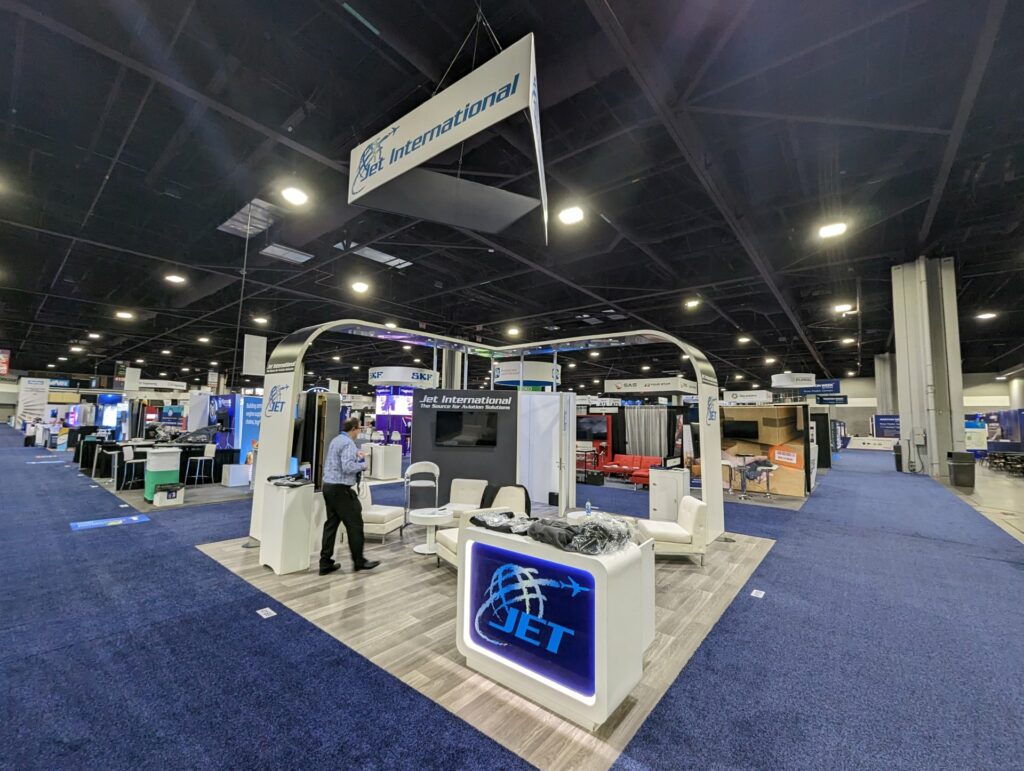
What Size Trade Show Booth Do I Need? Types of Trade Show Booths
There are several types of trade show booths, each with its own set of advantages and considerations:
- Inline Booths: These are standard booths positioned in a line, typically offering one open side for interaction. They are cost-effective and efficient for smaller exhibitors or those with limited budgets. However, their size and location can limit visibility and foot traffic.
- Peninsula Booths: Peninsula booths are open on three sides, providing greater visibility and access to visitors. They work well for exhibitors wanting more exposure and space for product displays or demonstrations. The challenge is designing a layout that effectively uses the open space to attract and engage visitors.
- Island Booths: Offering access from all four sides, island booths are highly visible and offer maximum exposure. They are ideal for large exhibitors looking to make a significant impact, host demonstrations, or display numerous products. However, they require more investment and careful design to manage visitor flow and maximize the space.
Each booth type has its pros and cons, and the choice depends on your objectives, audience, budget, and the nature of your products or services.
Find out the most popular tradeshow booth accessories.
Space and Layout Considerations
Calculating the space needed for your trade show booth is a critical step in ensuring a successful exhibition. Begin by listing all the elements you plan to include in your booth, such as product displays, demonstration areas, meeting spaces, storage, and any technology components like screens or interactive stations. For product displays and demonstrations, allocate enough space to showcase your products effectively and allow visitors to interact with them comfortably. Meeting areas should be sized based on the number of people you expect to host simultaneously, ensuring privacy and comfort.
It’s also crucial to consider the flow of visitors through your booth. There should be a clear path that guides visitors through the space, allowing them to engage with different elements without congestion. Similarly, consider the movement and workspace required for your booth staff. They need enough room to interact with visitors, conduct demonstrations, and move about freely without overcrowding the space.
Remember, a well-planned layout can make even a small booth feel spacious and welcoming, while a poorly planned large booth can feel chaotic or underutilized.
What Size Trade Show Booth Do I Need? Budgeting for Booth Size
The size of your trade show booth directly impacts various cost factors:
- Rental Costs: Generally, larger booths cost more to rent. This is a primary consideration when budgeting, as booth space rental can be a significant portion of your trade show expenses.
- Design and Construction: Larger booths may require more elaborate design and construction efforts, driving up costs. Consider the complexity of your booth design and the materials needed.
- Transportation and Setup: Bigger booths typically entail higher transportation and setup costs. This includes shipping your booth components to the venue and the labor costs associated with assembling and dismantling the booth.
To maximize budget efficiency, consider the following tips:
- Prioritize Key Elements: Focus your budget on the most important aspects of your booth that align with your objectives. For example, if product demonstration is key, allocate more budget to creating an engaging demo area.
- Modular Design: Use modular booth components that can be reconfigured for different shows. This approach allows for flexibility in booth size and layout, depending on your needs and budget for each event.
- Rent vs. Buy: Evaluate the cost-benefits of renting booth components versus purchasing them. Renting can be more cost-effective, especially for infrequent exhibitors or those requiring different booth sizes for different shows.
- Plan Early: Early planning can lead to cost savings, as last-minute arrangements often come with premium prices. Also, early booking of space often secures better rates and locations.
By carefully considering these factors, you can choose a booth size that meets your needs without overspending, ensuring a more efficient and effective trade show experience.
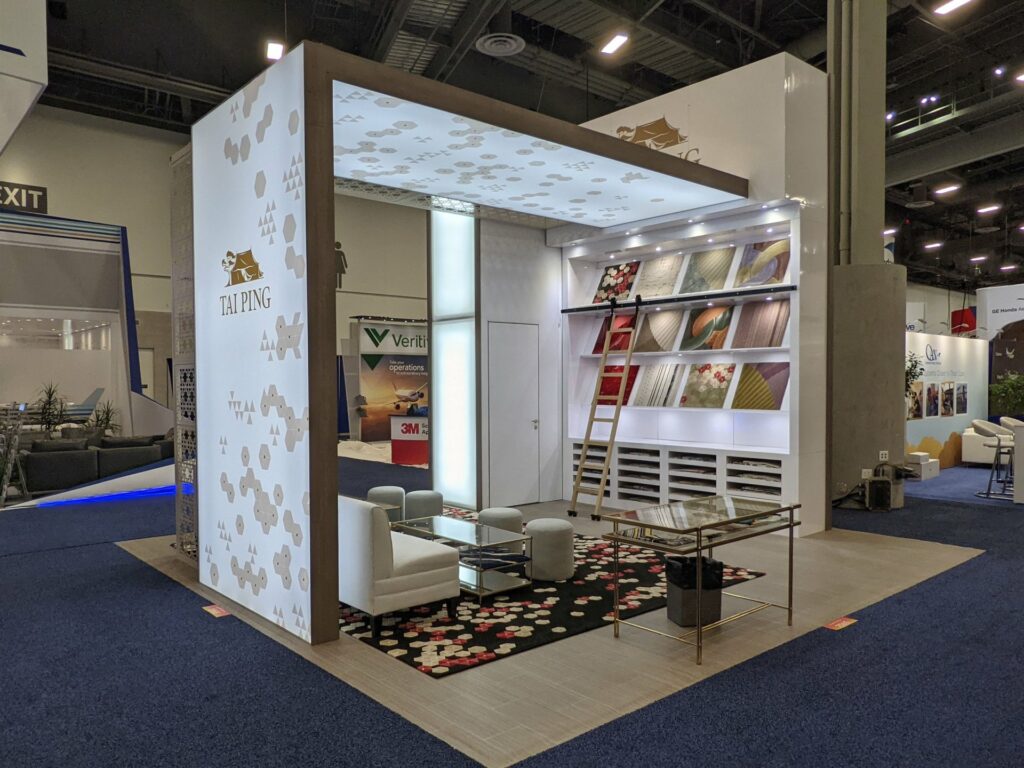
What Size Trade Show Booth Do I Need? Regulations and Restrictions
Navigating the regulations and restrictions of trade shows is essential for choosing the right booth size. Most trade shows have specific guidelines covering booth dimensions, height limits, signage, lighting, and even the materials used. These rules are often set to ensure safety, fairness, and visual harmony among exhibitors.
To work within these constraints, start by thoroughly reviewing the exhibitor manual or guidelines provided by the trade show organizers. Pay attention to the maximum height allowed for your booth type, as this can impact your design and signage plans. Also, be mindful of rules regarding booth boundaries; some shows strictly prohibit encroaching into aisles or neighboring booths.
If you have a specific booth design in mind, it’s wise to confirm its feasibility with the event organizers before finalizing your plans. In cases where regulations seem too restrictive, consider creative solutions that comply with the rules yet still capture the essence of your brand and meet your objectives. For instance, if height restrictions limit your signage, focus on innovative lighting or digital displays at eye level to attract attention.
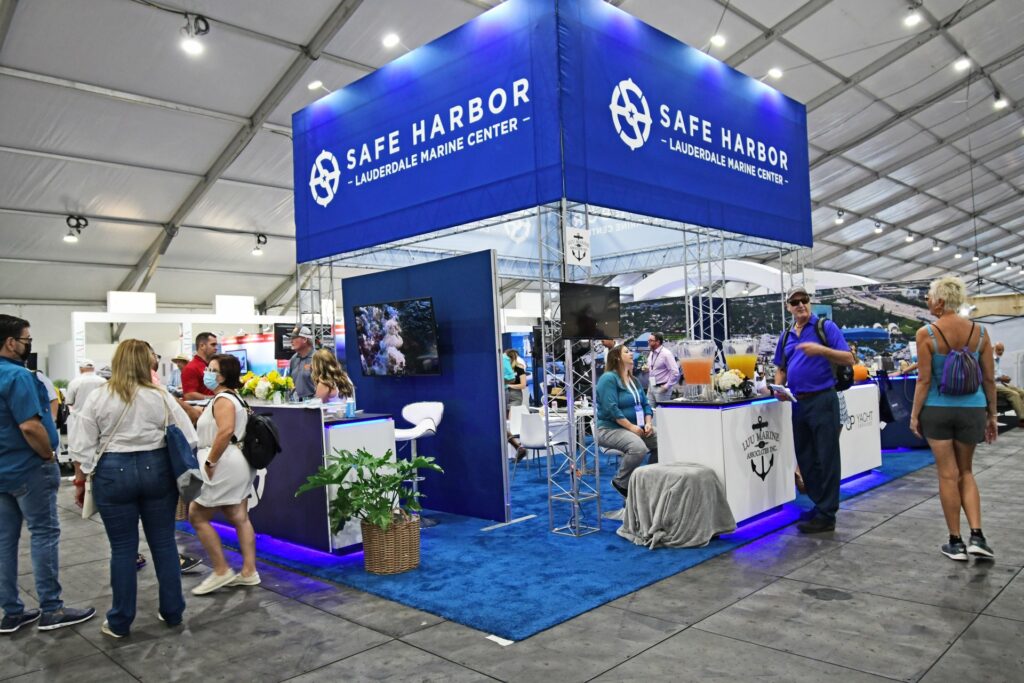
Design and Branding in Different Booth Sizes
Effective branding and design are crucial for making a lasting impression, regardless of booth size. Here are some tips for each type of booth:
- Small Booths: In compact spaces, focus on clear, impactful messaging and branding. Use vertical space wisely with tall banners or hanging signs. Ensure every element in the booth serves a purpose, whether it’s for branding, product display, or visitor interaction. Keep the design simple yet bold to attract attention without overwhelming the space.
- Medium Booths: With more space, you can create distinct zones for different interactions, such as a demo area, a consultation space, and product displays. Use consistent branding throughout the booth to create a cohesive look. Interactive elements like touchscreens or product trials can engage visitors more deeply.
- Large Booths: Large booths offer the most flexibility in design. You can create immersive experiences, larger product displays, or even host presentations. However, ensure that the space doesn’t feel empty or intimidating. Use bold, large-scale graphics, and create clear paths for visitors to explore different areas of the booth.
Read my guide how to have a successful trade show booth.
Analyzing Past Experiences and Industry Trends
Reflecting on past trade show experiences can provide valuable insights into future booth size decisions. Analyze the data from previous exhibitions, such as visitor traffic, engagement levels, staff experiences, and overall booth functionality. Consider questions like: Was the booth size adequate for the number of visitors? Did the size allow for effective product display and interaction? How was the staff’s ability to manage and engage with visitors? Use these reflections to identify what worked well and what could be improved in terms of booth size and layout.
Staying abreast of current trends in booth sizes and designs is also crucial. The trade show industry is continually evolving, with trends like immersive experiences, sustainable materials, and digital interactivity becoming more prominent. For example, smaller booths might trend towards more digital interactive elements to maximize space, while larger booths could focus on creating experiential zones. Industry publications, trade show reports, and competitor analysis can provide insights into these trends, helping you align your booth design and size with current best practices.
Find out the most popular trade show furniture.
What Size Trade Show Booth Do I Need? Practical Tips for First-Time Exhibitors
For newcomers to trade shows, selecting the right booth size can seem daunting. Here are some practical tips and a checklist to help first-time exhibitors:
- Understand Your Goals: Clearly define what you want to achieve at the trade show – whether it’s brand exposure, lead generation, or direct sales. This will guide your booth size and design decisions.
- Budgeting: Determine your overall budget for the event, including booth rental, design, staffing, and additional expenses. This will help you understand what booth size you can afford.
- Research the Event: Understand the audience and typical foot traffic of the trade show. This information can be obtained from the event organizers or past exhibitors.
- Consult with Experts: Don’t hesitate to seek advice from trade show design companies or consultants. They can provide valuable insights based on your specific needs and objectives.
- Checklist for Booth Planning and Preparation:
- Booth Size and Location: Decide on the size and book your space. Aim for a location that aligns with your traffic and visibility goals.
- Design and Branding: Plan the booth design, focusing on brand consistency and visitor engagement.
- Logistics: Organize the logistics, including transportation, setup, and breakdown of your booth.
- Staff Training: Prepare your team, ensuring they are well-trained and knowledgeable about your products and objectives for the show.
- Marketing Materials: Prepare marketing materials like brochures, business cards, and digital content.
- Promotion: Promote your participation in the trade show through social media, email marketing, and other channels.
- Post-Show Plan: Have a plan for following up with leads and contacts post-event.
By following these tips and using the checklist, first-time exhibitors can make informed decisions about booth size and prepare effectively for a successful trade show experience.

What Size Trade Show Booth Do I Need? Conclusion
Determining what size trade show booth do I need is a multifaceted decision that requires careful consideration of your business goals, target audience, budget, and the latest trends in the trade show industry. Whether you’re a first-time exhibitor or a seasoned participant, the size of your booth is a critical factor that can significantly impact your trade show success. It’s not just about the physical space, but how you utilize it to create an engaging, memorable experience for your visitors while also achieving your business objectives.
Remember, the ideal booth size balances visibility and functionality, aligning with your budget and the unique constraints of the trade show environment. Use your past experiences and industry trends as a guide, and don’t hesitate to seek advice from experts. With thorough planning, a clear understanding of your goals, and a strategic approach to booth design and layout, you can select a booth size that not only meets your needs but also positions you for a successful and impactful presence at your next trade show.
What Size Trade Show Booth Do I Need? FAQs
How do I determine the right size for my trade show booth?
Consider your business objectives, the nature of your products or services, expected foot traffic, and your budget. Larger booths may be necessary for extensive product displays or immersive experiences, while smaller booths can be ideal for focused interactions and lower budgets.
Does a larger booth guarantee more visitor engagement?
Not necessarily. Engagement depends on effective booth design and staff interaction, not just size. Even a small booth can attract and engage visitors if it’s well-designed and manned by proactive staff.
Should first-time exhibitors opt for smaller booths?
First-time exhibitors often start with smaller booths to manage costs and gauge their return on investment. However, the decision should also be based on your marketing goals and the scale of your product display needs.
Are there standard sizes for trade show booths?
Yes, standard booth sizes often range from 10×10 feet to 20×20 feet. However, sizes can vary based on the trade show and the layout of the exhibition space.
How can I make a small booth stand out?
Use creative designs, bold graphics, effective lighting, and interactive elements. A clear, compelling message and a well-trained, engaging booth staff are also crucial.
What factors should I consider for booth design in relation to size?
Consider visitor flow, space for demonstrations, meetings, and storage, as well as branding elements. Ensure the design is functional and reflects your brand, regardless of size.
How does booth size affect budgeting?
Larger booths typically cost more in terms of rental, design, construction, and staffing. It’s important to balance the desire for a larger space with the financial implications it brings.
Can I change my booth size if my business objectives change?
Yes, you can adjust your booth size for future trade shows based on your experiences and evolving business objectives. Modular booth designs offer flexibility to scale up or down as needed.
What are some common mistakes to avoid when choosing a booth size?
Avoid underestimating the space needed for comfortable visitor flow, overestimating the budget, and neglecting the importance of booth design and staff training.
How far in advance should I plan my booth size and design?
Start planning several months in advance. Early planning allows for better decision-making, cost savings, and ensures you get the desired booth location and size.
Learn more about trade show booth design:
- Planning to attend a trade show in the near future? Reach out to our experts in trade show booth design for assistance!
- Are you in need of trade show services in Tennessee? Reach out to our expert trade show booth design team in Nashville!
- Planning to attend a trade show? Discover valuable trade show booth design tips to craft the ideal exhibition booth for your needs!
- Explore trade show booth tips that cover everything from preparation to generating leads.

It’s in the name! Everything Tradeshows is your one-stop shop for all things trade shows, including booth purchases, booth rentals, and complete brand management services. Ready to get started? Have questions? Get in touch by calling us at (954) 791-8882 or by filling out the form below. We can’t wait to hear from you!

